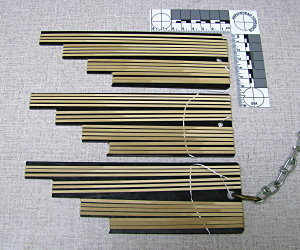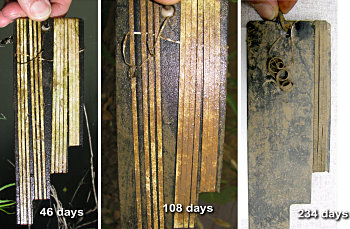|
Fact: Rubber bands were found intact on the bundles of D.B. Cooper money but crumbled off when touched. |
|
Introduction When the three bundles of D.B. Cooper money was uncovered on Tena Bar by Brian Ingram in Methods Rubber bands were sourced from the original manufacturer that supplied the west coast banks in the 1970's [2]. The companies technical people provided rubber bands of similar type and composition to those used at that time [3]. The rubber bands were stretched to 150%, 180%, 216% and 250% beyond their zero tension lengths on a plastic fixture (Fig. 1). One fixture was chained in the San Pedro River in southern Arizona (Fig. 2). A second fixture was buried in a tray under one inch of sand in the back yard of a private residence within ten miles of Tena Bar (Fig. 4). The third fixture was a control and left in a drawer in the lab. Both test fixtures were removed at intervals to determine the decomposition rate. Discussion The rubber bands around the Cooper bundles were extremely degraded but still in their proper positions when found. The original rubber band manufacturer that supplied all the If the bundles had been exposed to the elements for an extended period, then the rubber should have degraded and lost the ability to hold the bundles together. Since the rubber bands were found intact, this places a "degradation limit" on when the bundles became buried on Tena Bar. In order to place constrains on the degradation limit, the first of two experiments was conducted with rubber bands submerged in a river in Arizona. Figure 2 shows the stages of rubber band decomposition under water. After submersion for 234 days, all the bands were broken except the group with the smallest initial 150% stretch. These remaining bands had become permanently stretched to the 150% point and did not retract in size when removed. When the bands were stretched an additional 25%, they broke. Figure 3 shows the level of degradation closeup and illustrates how tenuously the bands were still in place. This experiment suggests that a rubber band lifetime of less than a year would be expected in fresh In order to mimic the conditions of sand burial on Tena Bar, a second experiment was constructed where the rubber band fixture was buried under an inch of beach sand and left outside in a residential backyard in Portland. The condition of the bands after 46 and 108 days is shown in Figure 4. By the 355th day all the bands were broken and none were left intact. This experiment also indicates that rubber bands under sand, have similar lifetimes to submerged bands which is less than a year. The control fixture had all its bands intact after two years. This suggests that the degradation and final breakage of the bands "in nature" within a year, were due to environmental factors. Conclusions The oxidation of sulfur in rubber bands is a well understood process and in fact, the first experiments to detect ozone in Los Angeles used rubber bands around jars [5]. The dual experiments performed here under conditions that are thought to be close analogues of for the bundles on Tena Bar, place an upper limit of about a year on the survivability of the Cooper rubber bands. This data along with other information presented elsewhere in this research, suggests that the money became buried on Tena Bar sometime within a year of the hijacking. The dredging theory Acknowledgments Special thanks to Gene and Linda Cattau and Chris and Jim Trappe for their assistance. References 1. FBI Transcript: "As he did so, the boy turned up three bundles of money wrapped with rubber bands, which was a short distance below the surface of the sand. The boy picked up the money and they looked at it and determined that it had once been $20 bills." "The money was badly decomposed and was held together with rubber bands which were so old they crumbled away immediately upon handling." 2. Alliance Rubber Company, Hot Springs, AR In business since 1923 producing rubber bands. 3. Personal Communication, Dennis Long, Alliance Rubber, Technical Dept.: Mr. Long in a phone conversation confirmed that they were the major supplier to all the west coast banks in 1971. He further stated that the differences in chemical composition of their rubber bands produced 1971, to the bands they supplied for testing, would be minimal. Mr. Long provided a significant number of the proper rubber bands for use in testing for which we are grateful. 4. Mechanism of Rubber Aging, B. L. Johnson, F.K. Cameron, Ind.Eng. Chem.,1933, pg 1151 5. "After tire manufacturers noticed that rubber deteriorated faster in Los Angeles than other areas of the country, researchers at Cal Tech showed air pollution to be the cause. They found that rubber exposed to high smog levels cracked in just seven minutes. Thus was born one of the early methods for measuring ozone levels -- stretching rubber bands around jars and timing how long the bands took to snap." South Coast Air Management District brochure. http://www.aqmd.gov/news1/Archives/History/marchcov.html
|



